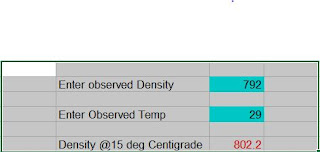Aniline Point fundamentals and Hydrocarbons analysis.
Aniline Point fundamentals and Hydrocarbons analysis
The article gives fundamentals
of Aniline and aniline point in hydrocarbon analysis.
This is useful leading to the
term “Patel’s aniline solubility Constant” – applied in determining
Aromatics quantitatively in hydrocarbons product in simple field test methods.
Aniline is a common organic compound with the formula C6H5NH2, having an amino group attached to a phenyl group. It is the prototypical aromatic amine.
ANILINE is a yellowish to
brownish oily liquid with a musty fishy sweet,
amine-like odor detectable at 0.6 to 10 ppm. Its Melting
point -6°C; boiling point 184°C; flash point 76°C.
Denser than water (8.5 lb /
gal) and slightly soluble in water.
Vapors are heavier than air. Toxic by skin absorption and inhalation.
Produces toxic oxides of nitrogen during combustion.
In purest
form, it is almost colourless, It becomes brown in the air or under the sun. It can be
distilled by steam. A small amount of zinc powder is added to prevent oxidation
when it is distilled. The solution of aniline is alkaline.
Its main use is in the manufacture of precursors to polyurethane and other industrial chemicals especially dyes, photographic chemicals, agricultural chemicals and others.
Terminology used in this and subsequent articles in aniline series:
Aniline point—the
standard test method ASTM D 611 / IP 2 , aniline point is the minimum
equilibrium solution temperature for equal volumes of aniline and sample.
Summary of Test Method:
Specified volumes of aniline and
hydrocarbon sample, is placed in a tube and mixed mechanically. The mixture is
heated at a controlled rate until the two phases become miscible. The mixture
is then cooled at a controlled rate and the temperature at which two phases
separate is recorded as the aniline point.
Significance and Use:
The aniline point is useful as
an aid in the characterization of pure hydrocarbons and in the analysis of
hydrocarbon mixtures.
Aromatic hydrocarbons
exhibit the lowest, and paraffins the highest values. Cycloparaffins and
olefins exhibit values that lie between those for paraffins and aromatics.
In homologous series the
aniline points increase with increasing molecular weight. Although it
occasionally is used in combination with other physical properties in
correlative methods for hydrocarbon analysis, the aniline point is most often
used to provide an estimate of the aromatic hydrocarbon content of mixtures.
Water
should not be used as either a heating or cooling medium since aniline is
hygroscopic and moist aniline will give erroneous test results. For example,
the aniline point of the n-heptane reagent as measured with aniline containing
0.1 volume % water is approximately 0.5°C (0.9°F) higher than that measured
with dry aniline.
Distilled
chemically pure aniline when tested with n-heptane shall give an aniline point
of 69.3 + 0.2°C (156.7 + 0.4°F).



Comments